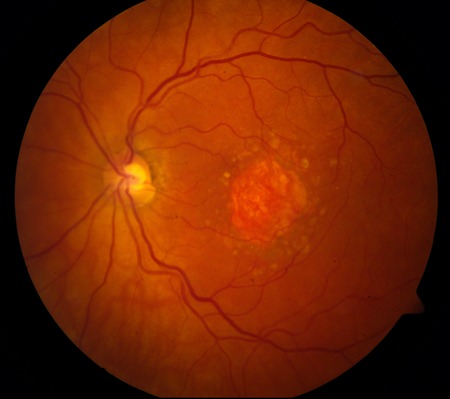
Washington (AP) – An experimental drug is showing promise against an untreatable eye disease that blinds older adults – and intriguingly, it seems to work in patients who carry a particular gene flaw that fuels the damage to their vision.
Age-related macular degeneration, or AMD, is the leading cause of vision loss among seniors, gradually eroding crucial central vision. There are different forms but more than 5 million people worldwide, and a million in the U.S., have an advanced type of so-called “dry” macular degeneration that has no treatment. At first patients may notice blurriness when they look straight ahead. Eventually many develop blank spots, becoming legally blind.
“These are seniors who are entering their golden years and now they’ve lost the ability to read, watch television, see their loved ones,” said Dr. Rahul Khurana, a retina specialist and spokesman for the American Academy of Ophthalmology.

The experimental drug, lampalizumab, aims to slow the destruction of light-sensing cells in the retina, creeping lesions that characterize the stage of dry AMD called “geographic atrophy.” When those cells die, they can’t grow back – the vision loss is irreversible.
What the research found
In an 18-month study of 129 patients, monthly eye injections of the drug modestly slowed worsening of the disease when compared with patients given dummy shots. What’s exciting for scientists came next, when researchers from drugmaker Genentech Inc. took a closer look at exactly who was being helped.
It turns out that nearly 6 in 10 of the study’s participants carry a gene variation that makes part of the immune system go awry – a genetic flaw already known to increase the risk of getting macular degeneration in the first place.
Those are the only patients who appeared to benefit from the drug; they had 44 percent less eye damage than the untreated patients, the Genentech team reported Wednesday in the journal Science Translational Medicine. While the study is too small to prove if lampalizumab really helps maintain vision, that’s a bigger difference than the overall results suggested.
Why would an immune-related gene affect aging eyes?
One arm of the immune system, the complement pathway, helps fight infections by attracting immune cells to attack bacteria.
Normally, there’s a barrier that keeps such cells away from the retina. But that barrier can break down with age, opening sensitive eye cells to harm from the spillover, explained Genentech immunologist Menno van Lookeren Campagne.
Now for the gene connection: Previous studies have linked macular degeneration to gene variations that remove some of that pathway’s natural brakes, so it can become too active.
The hypothesis: Genentech’s drug, lampalizumab, essentially offers a backup method for tamping down the immune reaction. An antibody, it works by inhibiting a particular enzyme named factor D that helps power the immune pathway.
“We try to reinsert the braking ability,” said study lead author Brian Yaspan, a Genentech senior scientist.
What’s next?
Wednesday’s study detected no safety concerns, clearing the way for Genentech and its parent company Roche to open two large-scale studies that aim to prove if the drug works. Results are expected later this year.
The current research sheds light on how that long-suspected immune culprit might be working, and is “the first suggestion that there may be a treatment for geographic atrophy coming up in the future,” said National Eye Institute retina specialist Dr. Wai Wong, who wasn’t involved in the study.
“It’s a very, very exciting study,” said Khurana, the ophthalmologist association’s spokesman, who also wasn’t part of the research. “From the basic science perspective, it makes a lot of sense.”
Health advice for now
Macular degeneration tends to occur after age 60, but it sometimes strikes earlier. According to the National Eye Institute, it’s less common in people who exercise regularly, avoid smoking, and eat a diet high in green leafy vegetables and fish.
Symptoms often aren’t noticeable early on. But several eye tests can detect signs of macular degeneration, including a dilated eye exam and a tool called an Amsler grid with straight lines that may look wavy if the macula, the center of the retina, is harmed.
Macular degeneration patients often are advised to take certain vitamin combinations that may help stave off advanced disease. And it’s important for patients to know what type they have. While there’s no treatment for the advanced dry form, the “wet” form occurs when leaky blood vessels grow under the retina – and there are several therapies that can help those patients preserve vision.




